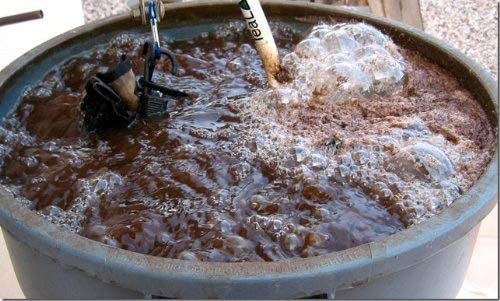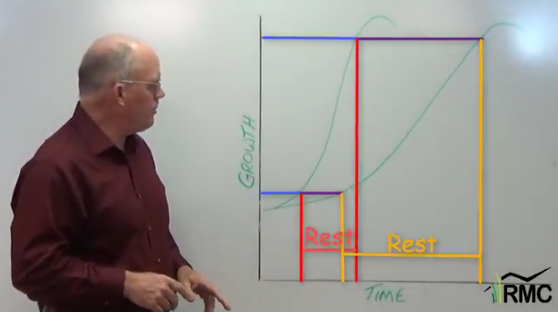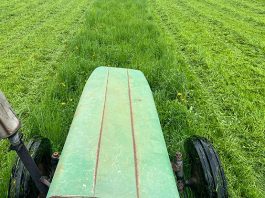This article is a condensed version of a series of a two article series from January of 2016. (Here is Part 1 and Part 2.) The results of this on-farm research are similar to the result Greg Judy described to me when he worked with Elaine Ingham on a trial of compost tea on his own farm.

Compost tea is a liquid extract of compost produced by steeping finished compost in water in an effort to extract beneficial microorganisms and compounds. It is made in a variety of ways, including with or without aeration, and with or without adding supplemental nutrient sources. The theory is that compost tea can add precisely what a soil is lacking and it is supposed to be a speedy, cost-effective way of improving soil health and plant growth.
But does it work? And is it better than simply spreading compost, or using cover crops? Those are the questions that farmer and retired chemist Jim Tarnowski set out to answer with his North Central Sustainable Agriculture Research and Education (SARE) project. Following are excerpts from his SARE report. You can read the full report here.
The Farms
 Four different Indiana farms, all part of the Wabash River Drainage Basin, investigated the use and effectiveness of aerobic compost tea for soil health restoration. Each farm is different in terms of the type of crops being grown. Farm One concentrated on commercial scale corn and soybean production, Farm Two on forage crop production, Farm Three on prairie and pasture restoration in a sensitive ecological area, and Farm Four on vegetable and orchard production. The study treatments were 1) use of aerobic compost tea vs. 2) water only – control. All four farms have a land history of conventional pesticide and fertilizer use, but are transitioning to organic techniques of management. Baseline comparison sites were also established for conventional no-till beans, native tall-grass prairie restoration, organic cropland, and long-term organically managed pasture near the four farms in this study.
Four different Indiana farms, all part of the Wabash River Drainage Basin, investigated the use and effectiveness of aerobic compost tea for soil health restoration. Each farm is different in terms of the type of crops being grown. Farm One concentrated on commercial scale corn and soybean production, Farm Two on forage crop production, Farm Three on prairie and pasture restoration in a sensitive ecological area, and Farm Four on vegetable and orchard production. The study treatments were 1) use of aerobic compost tea vs. 2) water only – control. All four farms have a land history of conventional pesticide and fertilizer use, but are transitioning to organic techniques of management. Baseline comparison sites were also established for conventional no-till beans, native tall-grass prairie restoration, organic cropland, and long-term organically managed pasture near the four farms in this study.
Objectives
Our main objective was to quickly improve and maintain soil health using sustainable, cost effective methods. Good quality compost is widely known to improve soil quality and health, as is cover cropping with deep rooted plants. However, the use of compost on a farm scale is a large investment of funds and locating a large enough supply to cover a field is an additional barrier to this approach. In recent years comments from some potato, grape, and strawberry producers in Western States, along with a growing number of gardeners, golf managers, horticulturalists and others extol the virtues of aerobic compost tea for improving soil and plant health.
Making and Using the Tea
Aerobic compost tea, made at the level of compost tea standards, contains many of the soil micro-biota necessary for a functioning soil system. If the use of compost tea can be shown to be effective at quickly restoring soil health, and the transition to adapting to and using compost tea is cost effective, then this may lead to a wider adoption among farmers. Restoration of soil health may then result in decreased reliance on pesticides and fertilizers, thus leading to a more sustainable farming system.

Protozoa play an important role in nutrient cycling by feeding intensively on bacteria. Notice the size of the speck-like bacteria next to the oval protozoa and large, angular sand particle.
Credit: Elaine R. Ingham, Oregon State University, Corvallis
Compost tea standards and expert recommendations were closely followed for brewing of tea and for application rates to fields. We hired an expert compost tea consultant to help train us in making and application of compost tea. Baseline tests determined the soil in all plots to be lacking in beneficial fungi. Recipes for producing fungal dominated compost tea were made and thoroughly tested for quality and biological parameters to ensure we were applying high numbers of beneficial fungi and other soil organisms. Our test results show that we applied good to excellent levels of beneficial bacteria and fungi to the soil. Extracting larger soil organisms such as protozoa and beneficial nematodes has proven very difficult and inconsistent. With careful observation and changes in the recipe for the compost tea we were able to achieve fungal dominated teas with excellent numbers of organisms.
Using typical tank sprayers free of residues, the aerobic compost tea was immediately applied following the 24 hour brewing process at a 20 gallon per acre rate as a soil drench in fall and spring. The spraying protocol was to use low pressure and flood spray tips with screens removed to ensure survival of the living organisms in the tea solution. This rate of application was recommended by soil food web experts for quick restoration of the soil ecology. Following the baseline soil samples, tea was applied the first fall and then the following spring, and then repeated again for a total of four applications per treated plot during the study duration.
Test Set Up
 Simple strip-plot design with two plots and one treatment per plot (Aerobic Compost Tea vs. Control Water) with three replicates for each treatment. Baseline soil samples were taken in September 2003 and then again exactly two years later in 2005, after the four applications of compost tea had been completed.
Simple strip-plot design with two plots and one treatment per plot (Aerobic Compost Tea vs. Control Water) with three replicates for each treatment. Baseline soil samples were taken in September 2003 and then again exactly two years later in 2005, after the four applications of compost tea had been completed.
Results
There were no significant effects on soil health indicators or soil food web organisms from the application of aerobic compost tea.
However, there were significant changes for several parameters which we believe were due to eliminated tillage and salt-based fertilizers and pesticides, while increasing cover cropping and the time that the soil had living plants growing. Both beneficial and fungal properties of the soil greatly improved during the two year study. In addition, aggregate stability, infiltration rates, and cation exchange capacity of the soil all significantly increased when comparing baseline results from 2003 with final results in 2005.
Benefits to Other Vegetation from Compost Tea

Outside of the study plots a few of us were applying much higher rates of compost tea to other plants and did see noticeable benefits. In one case, fire-blight problems in an orchard were brought under control with the use of foliar spraying. In another case, tomato starts were watered with compost tea and other were not. The compost tea fed tomatoes were much healthier and larger. It may be that we need to apply a much higher per acre rate of the compost tea to see soil benefits. Some of us feel there may be usefulness of the compost tea for foliar feeding and disease protection, but doubtful about its usefulness as a soil application.
Compost Tea Disadvantages
Disadvantages of the compost tea brewing are that it is expensive, takes considerable time and knowledge to brew decent teas, cleaning the brewer is a pain, and often the brew overflows or the equipment malfunctions. Tea brewing required a lot of baby sitting for the 24 hours it is brewing. Brewing the tea is more of an art than a science. The learning curve is very steep.
What Do Others Say About Compost Tea Success?
In speaking with soil microbiology researchers, Rodale farms, and others around the county investigating compost tea using scientific methods, none of them have found any clear benefits from soil or foliar uses. Some results have even showed negative impacts on plants. This is perplexing given the exponential growth in compost tea use around the country, the number of companies selling compost tea makers and equipment, and the increasing number of expert speakers on the benefits of compost tea at national organic tea among soil ecologists researching the soil food web.
There is clear evidence that the biodiversity of organisms in the soil is critical for full soil function and health, but so far no one has corroborated that the use of compost tea is effective in aiding the soil. Some of us find it troubling that the leading researcher and proponent of compost tea in the world has not published any peer reviewed and scientifically verified data supporting the claims that compost tea is effective. Some of us feel this begs the question: Is compost tea a magic elixir or simply snake oil? A lot of money is being made in the compost tea industry today.
Our Recommendations to Fellow Farmers and Ranchers
Unfortunately our results show there were no effects on soil health due to the compost tea treatments. Therefore we feel there may be a negative economic impact because brewing and applying compost tea was expensive and very time consuming.
We did find that our other soil health practices of reducing or eliminating tillage and artificial fertilizers and pesticides, while increasing cover cropping have been the most likely reason for improved soil. In some cases there were significant changes in soil health in just the short time period of two years. There are of course many other studies and practical observations from farmers and ranchers showing these conservation practices to be of benefit.
In conclusion we would advise other producers to trust in their own native soil observations and their intuitions about soil health. Rely on the tried and true methods of building soil health including: greatly reduce or eliminate tillage, especially deep tillage, eliminate pesticide use and salt-based fertilizer use. Employ the use of diverse cover cropping systems such that you always have a living crop in the soil. Use diverse crop rotations, and have animals as part of the system. Get to know other producers in you area or region who are trying to improve soil health and exchange knowledge with them.
We also advise producers to thoroughly investigate compost tea before investing money and time in this process. We advise this because we can find no credible scientific verification for the benefits of compost tea, and our own study found no impact on the soil health from the use of the compost tea. A further step with investigating compost tea will be to observe results form using various application rates of much greater quantities than we did in our study.





Very interesting. A few thoughts from me as a not-yet-practicing beginner:
1) 20 gallons per acre ~= 4 teaspoons per square meter (1 teaspoon every 3 square feet). Seems very little especially for a soil “drench”. IF healthy, diverse soil microbiology really DOES make a great difference to soil health and therefore productivity (which seems to be the case), and IF good quality compost DOES have these microorganisms present (which seems to be the case), and IF then brewing highly aerated compost tea DOES increase the numbers/concentration of these organisms (is this the case?), then it should follow that IF a sufficient critical mass of these organisms are applied to the soil in a manner that ensures they actually make their way into the soil AND TAKE HOLD, then compost tea *should* make a noticeable, measurable improvement to a pasture/cropland.
Most compost tea recipes say 1-2 cups of compost per 5 gallons ~= 1 part compost yields 40-80 times its volume in compost tea. So one ton/cubic yard of high quality aerated compost (~$200?) would yield 40-80 tons of tea, enough for 500-1000 (!) acres at the 20 gallon/acre rate in the study above.
My gut feel is that perhaps 20 gallons/acre is simply too little volume for these organisms to penetrate sufficiently into the soil and take hold and then multiply. A much stronger application, perhaps 10-100x the above concentration, might yield fundamentally different results. As these microorganisms are water-bound, such a lite drizzle basically leaves them on the very top of the soil, if they even make it that far and don’t get stuck on the plants.
What do you think?? Let me know! 🙂
-Ivan
Well, come back next week Ivan and we’ll answer some of your ifs. We’ll start with looking at whether or not you need to add more micro-organisms and move on from there
Kathy
P.S. Is Ivan Pavlov a nom de plume or your real name? Because it’s a great, and very famous name in my world! 🙂
I totally agree Ivan, it should work. However, it doesn’t in practice. For biology to thrive there must be a suitable home first. There must be a roof (ground cover), air to breath (good soil aggregation), and food to eat (root exudates). Until these three features are met, biology will not survive no matter how many you put in the soil.
Each time a trial does not produce the theoretical results wanted, someone is saying ‘you didn’t do it right’. I have been unable to find any research that proves compost tea does what the experts say it does. There are some cases where production improvements have been achieved, but each case has also been in conjunction with a management change like cover cropping or improved grazing practices. These management changes produce improvements regardless of any amendment.
Comments are closed.